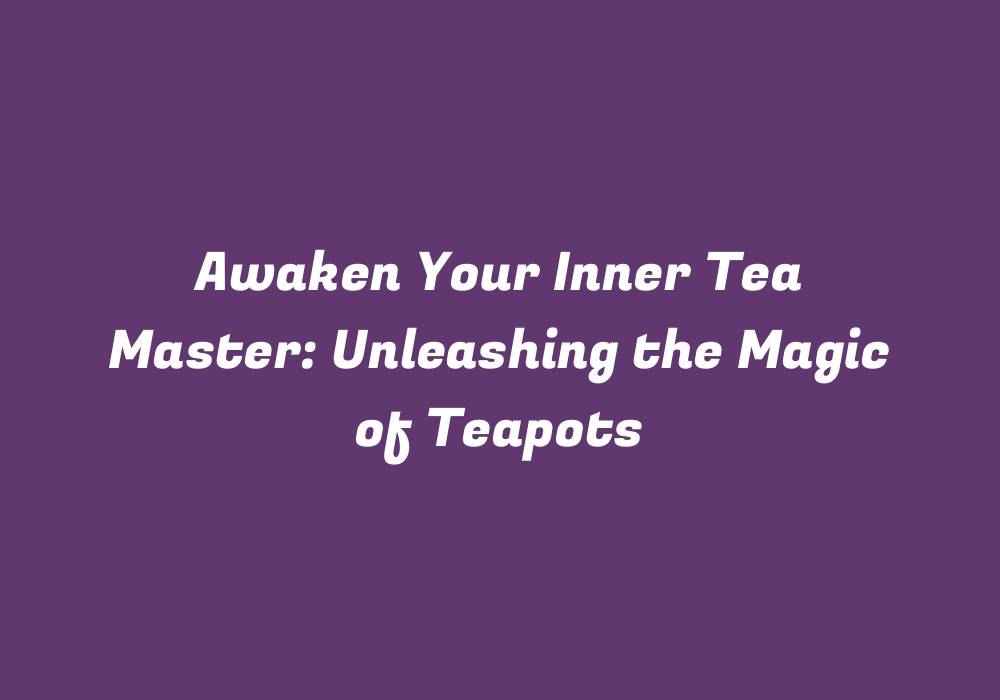Introduction
Tea drinking has been an artform for millennia. People from around the world have developed their own unique ways of creating delectable, soothing, and energizing beverages that are as much a part of their culture as they are a daily ritual. At the heart of these traditions lies the teapot – the vessel that not only holds tea leaves but also carries a wealth of history and symbolism. Let’s explore how to become your own inner tea master by awakening the magic within your teapots.
History and Evolution of Teapots
Teapots have evolved throughout history, adapting to suit various cultures and tea drinking practices. Ancient Chinese teapots were made of clay or porcelain, with small holes in their spouts to release steam for a more aromatic experience. Japanese kyusu teapots feature a strainer built into the lid to keep leaves from escaping into your brew. British teapots took on an entirely different form in the 17th century, becoming an elegant table centerpiece that reflected the wealth and status of its owners.
Choosing the Right Teapot for Your Needs
When selecting a teapot, consider what type of tea you most often drink and how much brewing capacity you require. For example, if you’re a green or white tea enthusiast who enjoys sipping in smaller doses, an 8-12oz pot would suffice. Lovers of black teas and large groups can opt for larger sizes, up to 40 oz or more.
Types of Teapots
There are several different types of teapots, each with their unique qualities:
1. Clay Teapots – These traditional Chinese teapots have a porous surface that allows the tea leaves to expand freely. The small holes in the spouts release steam, creating an aromatic experience. They are typically made from Yixing clay, which reacts with tea to enhance its flavors.
2. Glass Teapots – Transparent glass teapots allow you to monitor the brewing process closely and enjoy a beautiful sight of your tea leaves unfolding in the liquid. These pots can also be used for multiple infusions of loose leaf teas by simply adding more water after each steeping.
3. Stainless Steel Teapots – Durable and easy to clean, stainless steel teapots are perfect for those seeking an affordable option that doesn’t require the same level of care as ceramic or glass teaware. However, they may not be able to provide the same heat retention as other materials like porcelain or stoneware.
4. Porcelain Teapots – These elegant and sturdy pots are available in a wide variety of designs and colors to suit any taste. They offer excellent heat retention, keeping your tea at the optimal temperature for an extended period. However, they can be quite fragile if dropped or broken.
5. Stoneware Teapots – Made from clay-based material fired at high temperatures, stoneware teapots combine durability with a beautiful aesthetic that will only improve over time with use. These pots are perfect for those who appreciate the simple beauty of handmade pottery and enjoy the warmth it brings to their tea drinking experience.
6. Yixing Teapots – Named after the Chinese town where they originated, these classic teapots are made from a special type of clay that interacts with the tannins in certain teas, creating a unique taste profile. Each Yixing pot has its own character and can only be used for brewing specific types of tea to maintain this personalized flavor.
Tea Pot Care and Maintenance
To ensure your teapot stays in good condition and continues to perform at its best, it is important to clean and maintain it regularly:
1. Cleaning – Wash your teapot with warm soapy water after each use or when storing for an extended period. Make sure to rinse thoroughly to remove any soap residue that might affect the taste of your next brew. Avoid using abrasive cleaning materials as they may damage your teapot’s surface.
2. Seasoning – If you have a Yixing or clay teapot, seasoning is a crucial part of the pot’s lifespan and flavor development. By heating the pot with tea leaves inside for several sessions, the porous material will absorb the tea’s essential oils, which enhance its unique qualities and flavor over time.
3. Proper Storage – When not in use, store your teapot in a cool, dry location away from direct sunlight to prevent damage or discoloration. If necessary, wrap the teapot in a soft cloth to protect it during storage.
4. Tea Selection – Choose high-quality loose leaf teas that are free of additives and preservatives for optimal flavor enhancement when using your teapot. Avoid teas containing oils, which can create buildup on the pot’s interior and affect future brewing sessions negatively.
Conclusion
Awakening your inner tea master is an engaging journey that not only enhances your daily ritual but also deepens your appreciation for this timeless beverage. By selecting the right teapot, learning its care, and mastering its use, you can unleash the magic of brewing tea with a sense of accomplishment and satisfaction. With the proper teapot, you will not only elevate your tea experience but also become an integral part of this enduring tradition passed down through generations.
